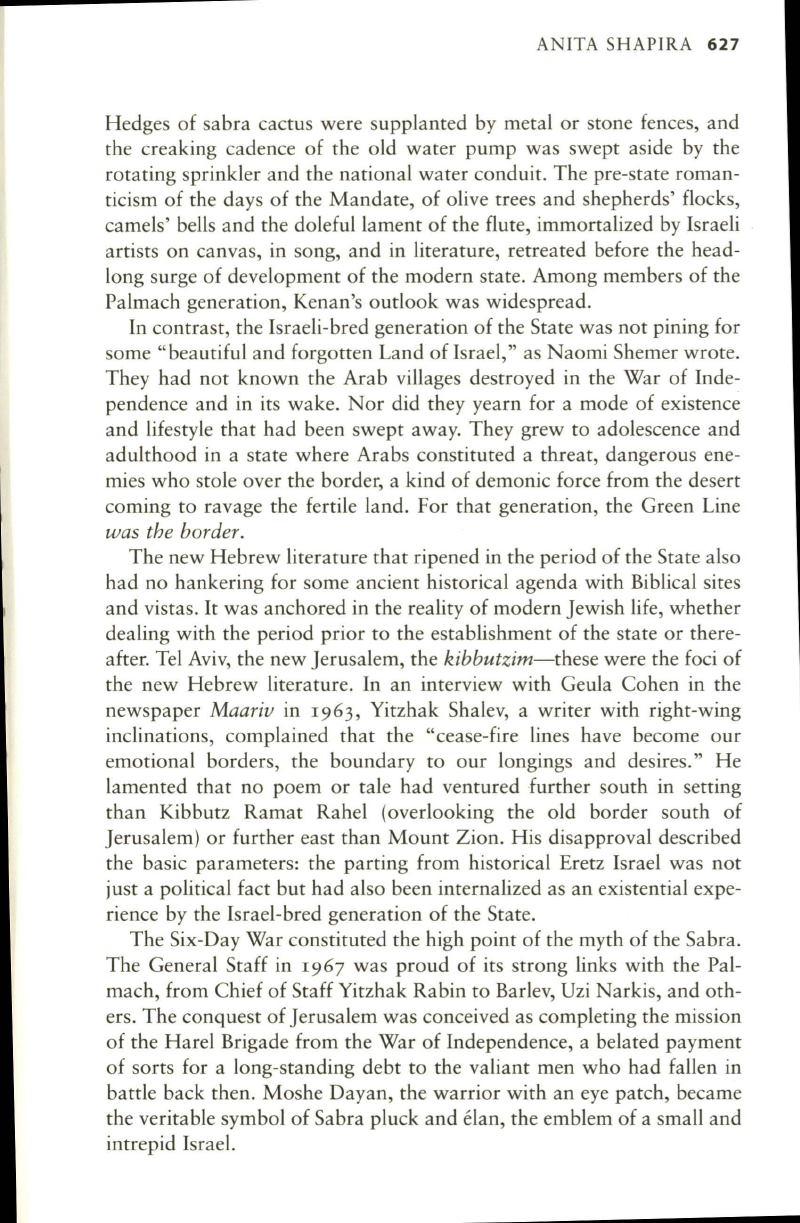
ANITA SHAPIRA
627
Hedges of sabra cactus were supplanted by metal or stone fences, and
the creaking cadence of the old water pump was swept aside by the
rotating sprinkler and the national water conduit. The pre-state roman–
ticism of the days of the Mandate, of olive trees and shepherds' flocks,
camels' bells and the doleful lament of the flute, immortalized by Israeli
artists on canvas, in song, and in literature, retreated before the head–
long surge of development of the modern state. Among members of the
Palmach generation, Kenan's outlook was widespread.
In contrast, the Israeli-bred generation of the State was not pining for
some "beautiful and forgotten Land of Israel," as Naomi Shemer wrote.
They had not known the Arab villages destroyed in the War of Inde–
pendence and in its wake. Nor did they yearn for a mode of existence
and lifestyle that had been swept away. They grew to adolescence and
adulthood in a state where Arabs constituted a threat, dangerous ene–
mies who stole over the border, a kind of demonic force from the desert
coming to ravage the fertile land. For that generation, the Green Line
was the border.
The new Hebrew literature that ripened in the period of the State also
had no hankering for some ancient historical agenda with Biblical sites
and vistas.
It
was anchored in the reality of modern Jewish life, whether
dealing with the period prior to the establishment of the state or there–
after. Tel Aviv, the new Jerusalem, the
kibbutzim-these
were the foci of
the new Hebrew literature. In an interview with Geula Cohen in the
newspaper
Maariv
in
1963,
Yitzhak Shalev, a writer with right-wing
inclinations, complained that the "cease-fire lines have become our
emotional borders, the boundary to our longings and desires." He
lamented that no poem or tale had ventured further south in setting
than Kibbutz Ramat Rahel (overlooking the old border south of
Jerusalem) or further east than Mount Zion. His disapproval described
the basic parameters: the parting from historical Eretz Israel was not
just a political fact but had also been internalized as an existential expe–
rience by the Israel-bred generation of the State.
The Six-Day War constituted the high point of the myth of the Sabra.
The General Staff in
1967
was proud of its strong links with the Pal–
mach, from Chief of Staff Yitzhak Rabin to Barlev, Uzi Narkis, and oth–
ers . The conquest of Jerusalem was conceived as completing the mission
of the Hare) Brigade from the War of Independence, a belated payment
of sorts for a long-standing debt to the valiant men who had fallen in
battle back then. Moshe Dayan, the warrior with an eye patch, became
the veritable symbol of Sabra pluck and elan, the emblem of a small and
intrepid Israel.


